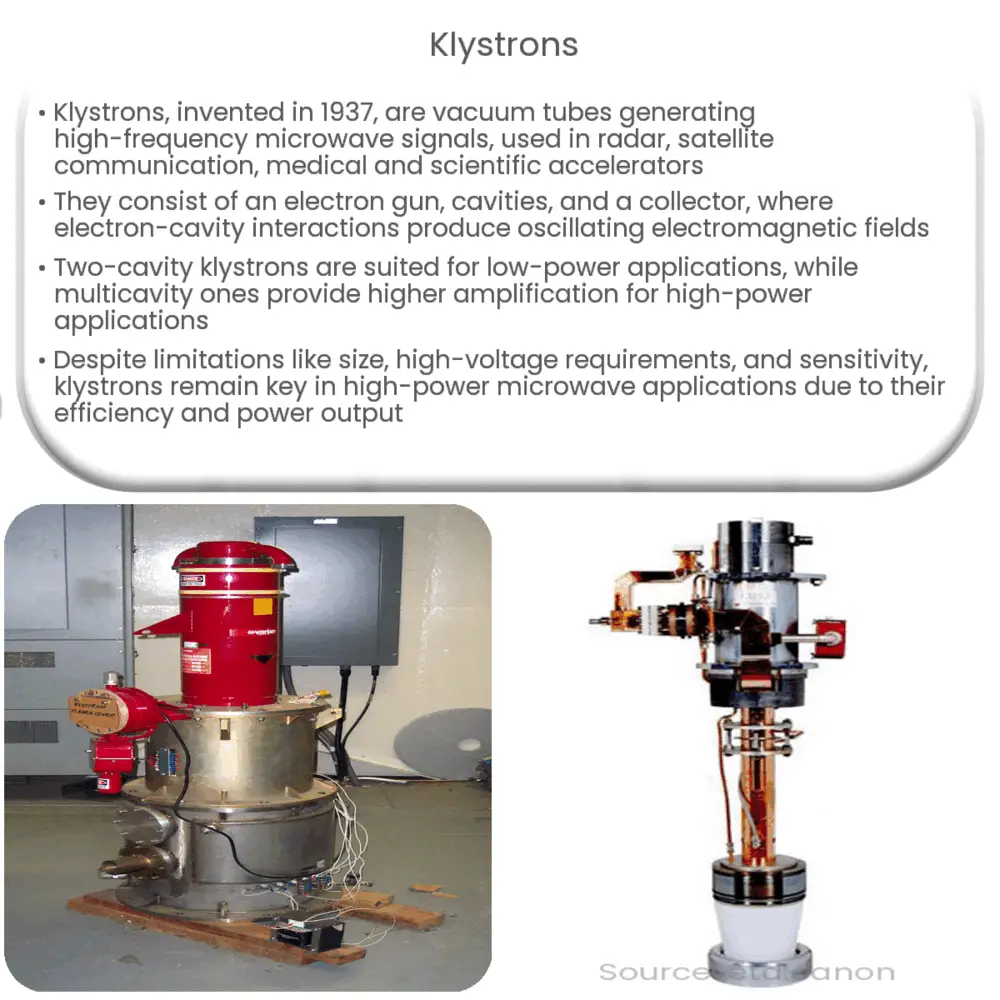Klystrons are vacuum tubes that generate and amplify high-frequency microwave signals, widely used in radar, satellite communication, and particle accelerators.

Klystrons: An Introduction to High-Frequency Vacuum Tube Technology
Overview of Klystrons
Klystrons are specialized vacuum tubes that generate and amplify high-frequency electromagnetic waves, specifically in the microwave range. They play a critical role in various applications such as radar systems, satellite communication, medical accelerators, and particle accelerators for scientific research. The invention of the klystron by Russell and Sigurd Varian in 1937 significantly advanced the field of radiofrequency technology and paved the way for numerous innovations in electronics.
How Klystrons Work
At its core, a klystron comprises an electron gun, a series of cavities, and a collector. The electron gun generates a beam of high-velocity electrons that travel through the cavities, which are resonant structures designed to interact with the electron beam. As the electrons pass through the cavities, they exchange energy with the electromagnetic fields inside, causing the fields to oscillate at a specific frequency. This oscillation produces high-frequency microwave signals, which can then be amplified and extracted for various applications.
Types of Klystrons
There are two primary types of klystrons: the two-cavity klystron and the multicavity klystron. The main difference between these two types lies in the number of cavities involved in the process of generating and amplifying microwave signals.
Two-Cavity Klystrons
Two-cavity klystrons, also known as reflex klystrons, consist of only two resonant cavities. The first cavity, referred to as the “buncher” cavity, imparts an initial velocity modulation to the electron beam. The second cavity, the “catcher” cavity, receives the bunched electron beam and extracts energy from it, generating an amplified microwave signal. Due to their simplicity, two-cavity klystrons are typically used for low-power applications, such as local oscillator sources in microwave receivers.
Multicavity Klystrons
Multicavity klystrons utilize multiple resonant cavities to achieve higher levels of amplification compared to their two-cavity counterparts. The electron beam interacts with each cavity in succession, gaining more energy and undergoing further bunching as it progresses through the klystron. The amplified microwave signal is then extracted from the last cavity. Multicavity klystrons are commonly used for high-power applications, such as radar transmitters and particle accelerators.
Advantages and Limitations
Klystrons offer several advantages, including their ability to produce high-power microwave signals with high efficiency and exceptional frequency stability. However, they also have some limitations, such as their relatively large size, high-voltage requirements, and sensitivity to mechanical vibrations. Despite these drawbacks, klystrons remain indispensable in various high-power microwave applications due to their unmatched performance characteristics.
Applications of Klystrons
Klystrons have been widely adopted in numerous fields, thanks to their unique capabilities. Some notable applications include:
Radar Systems
Klystrons serve as high-power microwave signal generators and amplifiers in radar systems, enabling the detection and tracking of objects at great distances. Their exceptional frequency stability and output power make them ideal for this purpose.
Particle Accelerators
Particle accelerators, such as the Large Hadron Collider (LHC), rely on klystrons to generate the high-power microwave signals required to accelerate charged particles to near-light speeds. These particles are then collided with one another, allowing scientists to study the fundamental building blocks of the universe.
Medical Linear Accelerators
Klystrons are also employed in medical linear accelerators, which are used for cancer treatment through radiation therapy. High-energy X-rays generated by the accelerators target cancerous cells while minimizing damage to healthy tissues.
Satellite Communication
Satellite communication systems use klystrons as high-power amplifiers to transmit and receive signals between ground stations and orbiting satellites. Klystrons are favored for their ability to deliver stable, high-power signals over long distances with minimal loss.
Future Developments and Challenges
As technology advances, the demand for higher power, increased efficiency, and smaller form factors continues to grow. Researchers are actively exploring new klystron designs and materials to meet these requirements. For example, the development of solid-state klystrons aims to reduce the size and complexity of conventional klystrons while maintaining their superior performance characteristics.
One of the challenges faced by klystron technology is the competition from alternative microwave signal generation and amplification technologies, such as solid-state amplifiers and traveling-wave tubes. These technologies offer certain advantages over klystrons, including a smaller footprint and lower operating voltages. However, klystrons continue to excel in high-power applications where their unparalleled efficiency and output power are crucial.
Conclusion
Since their invention in 1937, klystrons have played a pivotal role in the advancement of high-frequency vacuum tube technology. Their ability to generate and amplify high-power microwave signals with exceptional frequency stability has made them indispensable in various applications, from radar systems and satellite communication to particle accelerators and medical equipment. Despite the emergence of competing technologies, klystrons remain an essential component in many high-power microwave systems, and ongoing research aims to further improve their capabilities to meet the ever-evolving demands of modern technology.

